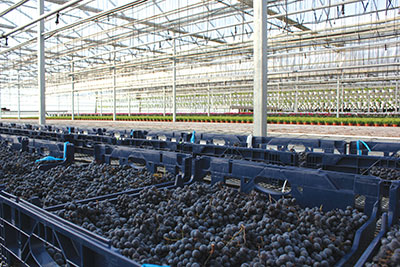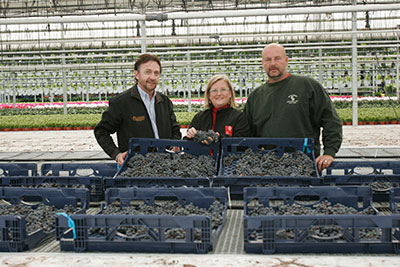
Greenhouses offer the perfect environment for getting the most out of floral and vegetable crops.
Greenhouses offer the perfect environment for getting the most out of floral and vegetable crops.
Oh, and wine grapes, too.
 |
|
| Zalm of European Planters. Photos COURTESY KAITLYN LITTLE/BROCK
|
Ontario wineries have long attracted international attention for the variety and quality of their wines, bringing home numerous awards each year.
It’s a $3.3-billion industry with 14,000 employees.
Much like the Ontario greenhouse floriculture sector, most of it is centred in the Niagara region, an ideal home for growing grapes due to its moderate climate and fine soils.
But the weather in late-fall can be erratic, notes Dr. Debbie Inglis, director of the Cool Climate Oenology & Viticulture Institute at Brock University in St. Catharines. “We can face lots of rain, humidity and cold snaps that don’t allow us to simply leave the grapes on the vine to further ripen to get to the flavour level we would want.”
Developing new winemaking styles to help mitigate some of these risks is important for the continued growth of the industry.
APPASSIMENTO STYLE OF WINEMAKING
That’s where the appassimento style of winemaking comes in. An increasing number of Ontario growers have embraced it in recent years. It’s been carried out for hundreds of years in northern Italy, another cool climate winemaking region.
The goal of appassimento winemaking is to allow the fruit to continue to ripen off the vine – and be sheltered from the erratic weather conditions – to concentrate sugars and flavours without increasing acidity.
The storage can last for days, weeks or a few months, depending on the type of storage conditions and the desired fruit characteristics.
The result is an especially full-bodied wine, a premium product. These wines are typically higher in alcohol content, about 14 to 15 per cent.
So what’s the tie-in between winemaking and greenhouses?
Little research has been carried out on grape drying methods … until now.
Inglis and her research associates have been working with $2.86 million in provincial funding to better understand how climate change will impact the province’s grape and wine industry and what the industry can do to adapt to these changes. Included in this research is work on optimizing the appassimento winemaking system with Ontario varieties and growing conditions.
The five-year project is in its fourth year.
COMPARING STORAGE OPTIONS: GREENHOUSES A GOOD OPTION
The group has been comparing five grape storage facilities:
- Bulk tobacco kilns.
- Greenhouses.
- Barns.
- A temperature and humidity drying chamber.
- Prolonged “hang-time” on the vine to allow the fruit to dry out naturally, similar to icewine production.
“This is a new style of wine for Ontario that’s developing,” says Inglis.
Currently, about 10 wineries in the region are producing it on a commercial scale, up from two or three just a few years ago.
“There is a growing interest in this,” Inglis notes, “but there are a lot of unanswered questions. We hope our project will assist the industry in coming up with standards and ways to really get the most out of the grape for this style of wine production.”
Appassimento winemaking is also being carried out on a smaller scale in other regions of Canada, including the Maritimes and Quebec.
The Brock study has been working with Cabernet franc, but the system is not limited to one variety, and indeed would be applicable to both white and red wines.
“We’re still working to determine the optimal drying conditions” with each storage system.
Greenhouses are a good fit with grape drying.
“What we’re looking for with the drying technique is a chamber of some sort that is protected from the external element, so we won’t be impacted directly by rain or snow or wind that would come into play if we were hanging the grapes out on the vine.”
GREENHOUSES IDEAL FOR CLIMATE CONTROL
Greenhouses are also ideal for ventilation, temperature and humidity control.
“Transportation is not a problem because there are so many greenhouses in the region.”
Timing also works well for greenhouse growers. The red varieties are typically harvested in mid to late-October.
“That’s a period of time, given our discussions with our greenhouse partners, that they’re finished with their summer crops and they’re just starting with their holiday crops. They have space for a few weeks within the greenhouse.”
The project has worked with both Sunrise Greenhouses and European Planters, two Niagara area companies known for innovation. Greenhouse staff went about their normal business while the grape bins were set out on benches in an area dedicated just for them. It was business as usual for them.
The drying period lasts from two to three weeks in greenhouse conditions, compared to three to five days in the kilns, and two to three months for the other three systems being studied.
“If the grapes are only coming in for two to three weeks, it’s a good use of open space.”
The grape crates are stackable and allow sufficient air flow even when stacked.
Some of the area wineries are already using greenhouses for their drying process.
LEADING EDGE RESEARCH FOR WHICH CCOVI IS WELL KNOWN
CCOVI is an internationally renowned research institute that works closely with its many winery partners.
 |
|
| Jamie Slingerland, director of viticulture at Pillitteri Estates Winery (left), Debbie Inglis, and Jim van der Zalm of European Planters.
|
“We are letting the world know we are innovators here in Ontario, and we need to be to remain competitive. There are challenges because of our changing climate and erratic weather; we definitely need to look outside the box to continue to deliver premium products to our consumers.
“And one of the ways we can further enhance the quality of the fruit we’re producing in the region is through the appassimento winemaking technique.”
One of the big questions not yet resolved – even in northern Italy – is whether the system requires some level of the noble rot form of Botrytis to be present. When this Botrytis fungus is inside the grape and breaking down the structure of the skin cells, it’s also modifying the flavour.
A key question is whether there’s a benefit of adding complexity to the wine by having a small amount of Botrytis present in the fruit, or should the fruit be completely clean of Botrytis?
The Brock team had a trial that compared a sampling of berries with zero per cent infection with a sampling in which 10 per cent of the grapes had the noble rot form of Botrytis.
“If some (noble rot) develops, do you need to remove it from the trays immediately or can you allow for a certain level to develop and not have to worry about having to sort that fruit out.”
STUDYING A NEW YEAST DRAWN FROM ICEWINES
The researchers have also isolated a natural yeast from the skin of icewine grapes. It’s a very low producer of the oxidation compounds that can result in the appassimento style of winemaking.
“In drying the grapes,” says Inglis, “sometimes we also get a bit of a buildup of these oxidation compounds in the fruit…these oxidation compounds can become an issue.”
The new yeast is being trialled in the appassimento system to see if it performs better than the commercial yeasts now on the market for this style of winemaking and can help develop this Ontario signature of appassimento wines more effectively.
Along with studying the different options available to dry the fruit, the team also hopes to have a unique yeast isolated from Ontario to go along with this style of wine.
This research will ensure Niagara remains the toast of the wine-making community.
Print this page